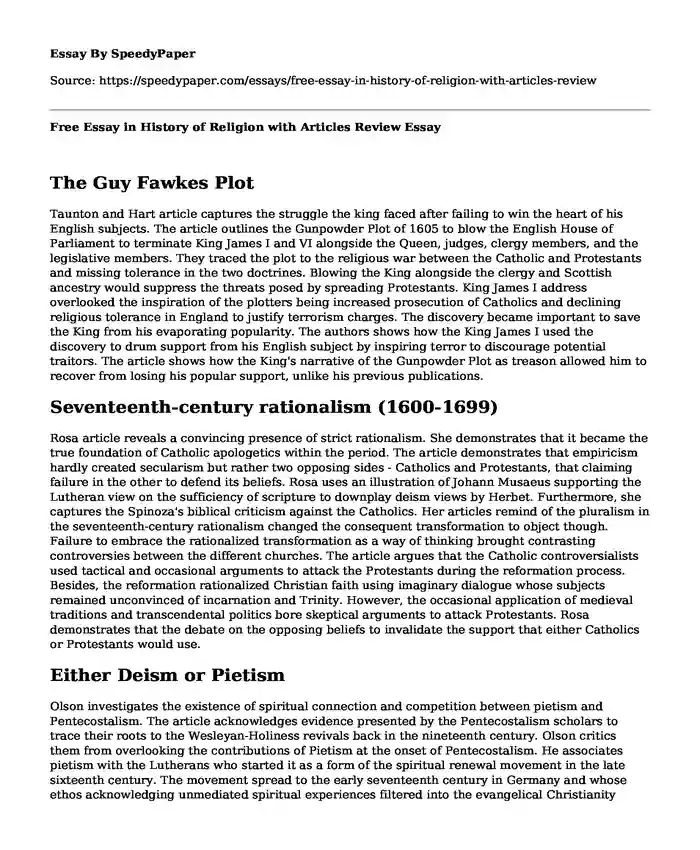The Guy Fawkes Plot
Taunton and Hart article captures the struggle the king faced after failing to win the heart of his English subjects. The article outlines the Gunpowder Plot of 1605 to blow the English House of Parliament to terminate King James I and VI alongside the Queen, judges, clergy members, and the legislative members. They traced the plot to the religious war between the Catholic and Protestants and missing tolerance in the two doctrines. Blowing the King alongside the clergy and Scottish ancestry would suppress the threats posed by spreading Protestants. King James I address overlooked the inspiration of the plotters being increased prosecution of Catholics and declining religious tolerance in England to justify terrorism charges. The discovery became important to save the King from his evaporating popularity. The authors shows how the King James I used the discovery to drum support from his English subject by inspiring terror to discourage potential traitors. The article shows how the King's narrative of the Gunpowder Plot as treason allowed him to recover from losing his popular support, unlike his previous publications.
Seventeenth-century rationalism (1600-1699)
Rosa article reveals a convincing presence of strict rationalism. She demonstrates that it became the true foundation of Catholic apologetics within the period. The article demonstrates that empiricism hardly created secularism but rather two opposing sides - Catholics and Protestants, that claiming failure in the other to defend its beliefs. Rosa uses an illustration of Johann Musaeus supporting the Lutheran view on the sufficiency of scripture to downplay deism views by Herbet. Furthermore, she captures the Spinoza's biblical criticism against the Catholics. Her articles remind of the pluralism in the seventeenth-century rationalism changed the consequent transformation to object though. Failure to embrace the rationalized transformation as a way of thinking brought contrasting controversies between the different churches. The article argues that the Catholic controversialists used tactical and occasional arguments to attack the Protestants during the reformation process. Besides, the reformation rationalized Christian faith using imaginary dialogue whose subjects remained unconvinced of incarnation and Trinity. However, the occasional application of medieval traditions and transcendental politics bore skeptical arguments to attack Protestants. Rosa demonstrates that the debate on the opposing beliefs to invalidate the support that either Catholics or Protestants would use.
Either Deism or Pietism
Olson investigates the existence of spiritual connection and competition between pietism and Pentecostalism. The article acknowledges evidence presented by the Pentecostalism scholars to trace their roots to the Wesleyan-Holiness revivals back in the nineteenth century. Olson critics them from overlooking the contributions of Pietism at the onset of Pentecostalism. He associates pietism with the Lutherans who started it as a form of the spiritual renewal movement in the late sixteenth century. The movement spread to the early seventeenth century in Germany and whose ethos acknowledging unmediated spiritual experiences filtered into the evangelical Christianity words in Europe and North America. Olson backs the connectivity of Pietism with Pentecostalism by demonstrating widespread speaking in tongues noted amongst the Scandinavians professing Pietism in Chicago. Again, he writes of ecstatic experiences among those occupying the upper Midwest region towards North America. Olson cites such experiences that occurred years before the introduction of Pentecostalism in Azusa and Topeka regions to demonstrate relevance in the connectivity with Pietism. The practices by the Scandinavian immigrants shows parallels in practical holiness, conversion and mission activism that would emerge in Pentecostalism during its introduction at the onset of the twentieth century. The findings in the exploration by Olson supports the existence of the spiritual connection between Pietism and Pentecostalism.
Bibliography
Olson, Roger E. "Pietism and Pentecostalism: Spiritual Cousins or Competitors?" The Journal of the Society for Pentecostal Studies 34, no. 3 (2012): 319-344.
Rosa, Susan. "Seventeenth-Century Catholic Polemic and the Rise of Cultural Rationalism: An Example from the Empire." Journal of the History of Ideas 57, no. 1 (January 1996): 87-107.
Taunton, Nina, and Valerie Hart. "King Lear, King James and the Gunpowder Treason of 1605." Journal of the Society for Renaissance Studies 17, no. 4 (December 2003): 695-715.
Cite this page
Free Essay in History of Religion with Articles Review. (2022, Apr 21). Retrieved from https://speedypaper.com/essays/free-essay-in-history-of-religion-with-articles-review
Request Removal
If you are the original author of this essay and no longer wish to have it published on the SpeedyPaper website, please click below to request its removal:
- Nursing Education Essay Sample
- Free Sample of the MBA Thesis Proposal Methodology
- Healthcare Policy and Nursing Research Paper Sample at No Charge
- Medical Surgical Nurses: Information about the Academy and Its Values
- Medicine Career - Personal Statement Essay Sample
- Ethical Crisis in the US Essay Sample
- Developing the Utopia City Project Paper Example
Popular categories





